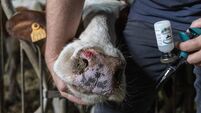See the light when milking
They have found that moving from double T8 fittings to half the number of T5 fittings would reduce power consumption on lighting by 40%, while still providing the recommended 500 lux of brightness.
Work at Moorepark showed that lighting accounts for 7% of total electrical energy used on Irish dairy farms. Moisture-resistant double fluorescents and high-bay metal halide lamps are the two most common types of lighting used on Irish dairy farms.
Teagasc energy audits showed that similar size dairies using metal halide lights can use over three times more electricity on lighting than a farm using fluorescent lights. This is because of the high wattage of the metal halide fittings.
Metal halide fittings are typically suspended from the dairy roof in a single row over the milker’s pit. The nature of this lighting strategy leads to shadows being cast by the milking machine, stallwork, milk meters and automatic cluster removers, leaving brightness in the milker’s pit often well below desired levels, where excessive shadows are cast.
Alternatively, two rows of double tube fluorescent lighting can be mounted over the edges of the pit. However, it was also found that modern fluorescent tube fittings tend to interfere with milking parlours’ automatic cow identification systems, reducing the effective distance from the cow’s ear tag to the antenna. The underlying reason is a high-frequency signal within the light fittings.
Where automatic cow ID systems are installed, older switch start or magnetic ballast fluorescent tubes are the only viable option.
The Teagasc researchers highlighted options to improve the efficiency of the double five foot, one inch T8 fluorescent tubes most commonly found in dairies.
The 40% smaller T5 fittings (5/8 inch) are recommended.
Converters are now commercially available to convert existing T8 fittings to T5 fittings without the requirement to change the fixture itself. The converters reduce the power consumed by the light fitting but at some expense of light output.
LED tubes are very efficient and would save 48% on power usage. But one LED tube costs about €85, compared to €10 per T5 tube, making them an unattractive option even when their longer life is taken into account.
The findings by research officer John Upton at Moorepark and Teagasc Walsh Fellow Michael Murphy are available in full in the summer edition of the TResearch magazine (see the publications section of the www.teagasc.ie website.













